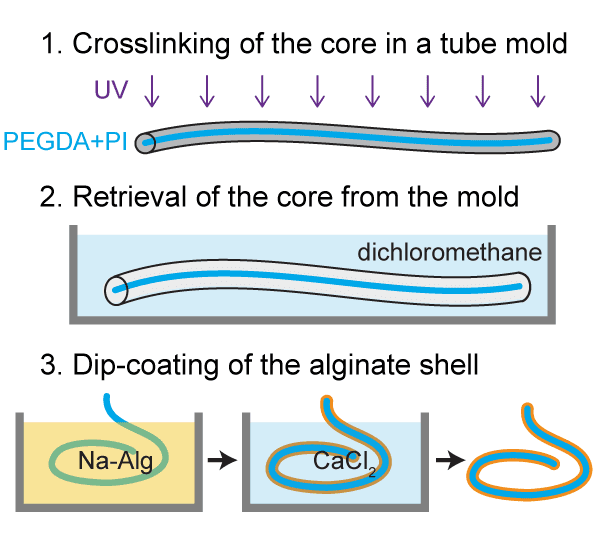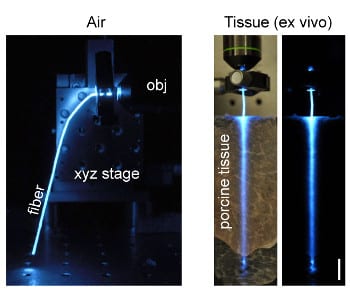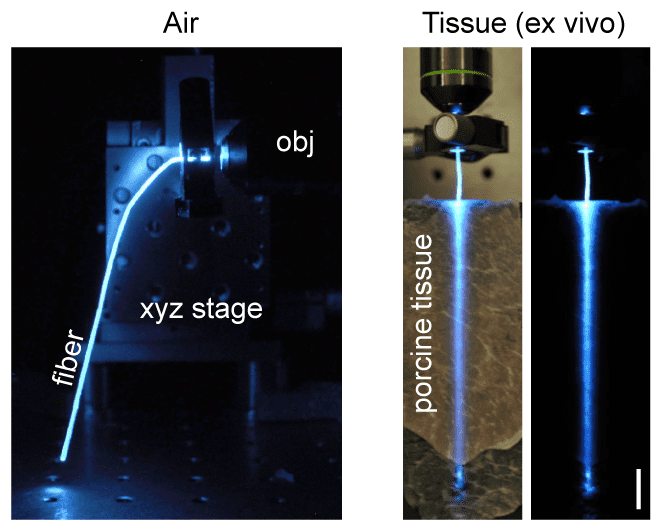Optical fibers find themselves in a number of biomedical applications, one notable example being endoscopy. However, despite a flexible light-guiding system, standard optical fibers are mostly made of glasses or inorganic plastics, rendering themselves incompatible with biological systems. The challenge is two-fold when it comes to the development of biocompatible optical waveguide materials. For one, light-guiding efficiency must be sufficient to transmit light across distances on the organ scale, roughly 10 cm for humans. For another, fibers based on current single-material approaches are highly susceptible to physiological environments.
After discovering that bulk hydrogels can be fabricated into light-guiding materials with excellent optical transparency, Seok-Hyun Yun and his team at Massachusetts General Hospital (USA), Sungkyunkwan University (Korea), J. Stefan Institute (Slovenia), and Korea Advanced Institute of Science and Technology (Korea) have taken this technique one step further. They have successfully fabricated a step-indexed optical fiber using flexible and biocompatible hydrogels.

Based on a core-cladding design similar to that of conventional optical fibers, the researchers first prepare photocrosslinked polyethylene glycol (PEG) hydrogel core inside a platinum-cured silicone tube. After its removal from the mold, the PEG hydrogel core is further coated with alginate, followed by calcium chloride treatment, which is repeated to afford multi-layer cladding. Unlike their previous design based on a single hydrogel with a uniform refractive index, the new design restricts light reflection at the core-cladding boundaries, and thus is not to be influenced by changes in the refractive index of the medium.
The light guiding performance of the hydrogel fiber proves to be excellent, and the penetration depth is over 10 cm in the visible spectrum. Another advantage of this new strategy is the ability to in situ dope chemicals, such as laser dyes and therapeutic materials, to the fibers, which may enable targeted optical health monitoring and light-based therapy, respectively. The researchers have shown that a dye-doped fiber can be used for optical amplification by enhancing guided fluorescence light traveling along the fiber. On the other hand, embedded gold nanoparticles are able to efficiently generate heat when the fiber is pumped with laser at the plasmonic resonance wavelength, a promising property for photothermal therapy.
This work is recognized as “a high-quality study on flexible and biocompatible hydrogel for optical healthcare monitoring”, as commended by one of the reviewers. To continue this achievement, the authors plan to screen “a broad spectrum of materials”, as well as “advanced fabrication techniques such as microfluidics and electrospinning”, which will further optimize the optical and mechanical characteristics of the hydrogel fibers. “In parallel”, the authors note, “we will look into functionalized fibers’ potential for medical applications”. For example, by incorporating optical sensors, the functionalized fibers may be used to sense physiologic parameters, whereas by incorporating cargo-loaded caged compounds, they may be used to in vivo secrete chemokines or hormones at targeted locations. As the authors envision, one combined effort is to “mimic biological organ functions such as glucose homeostasis by the pancreas”, which can sense glucose levels and regulate insulin secretion accordingly.


















